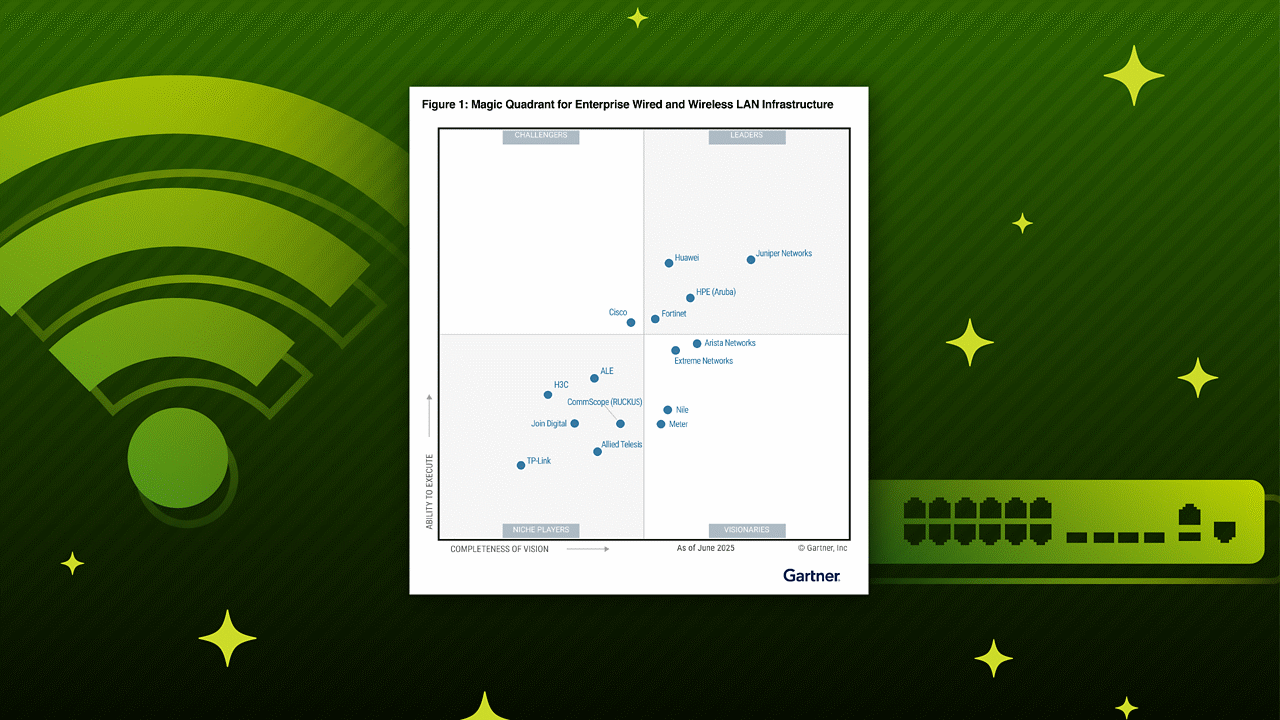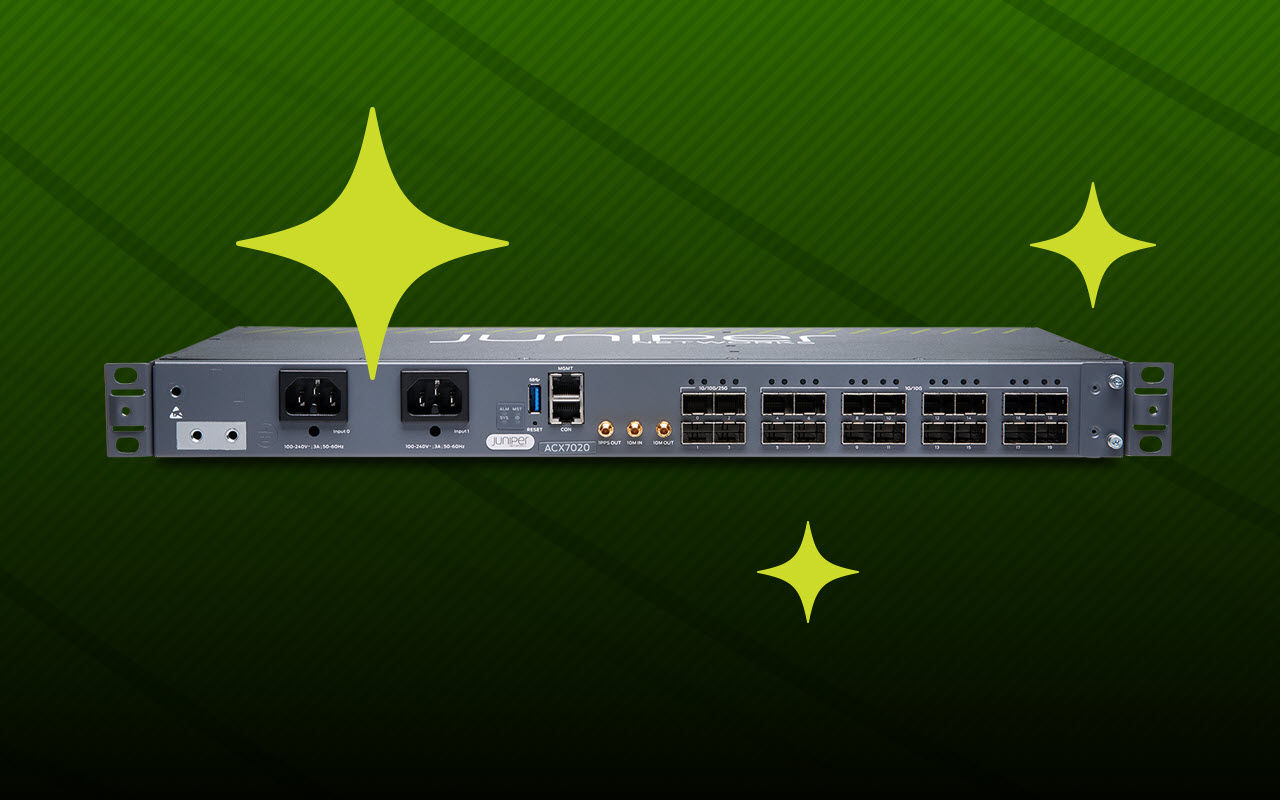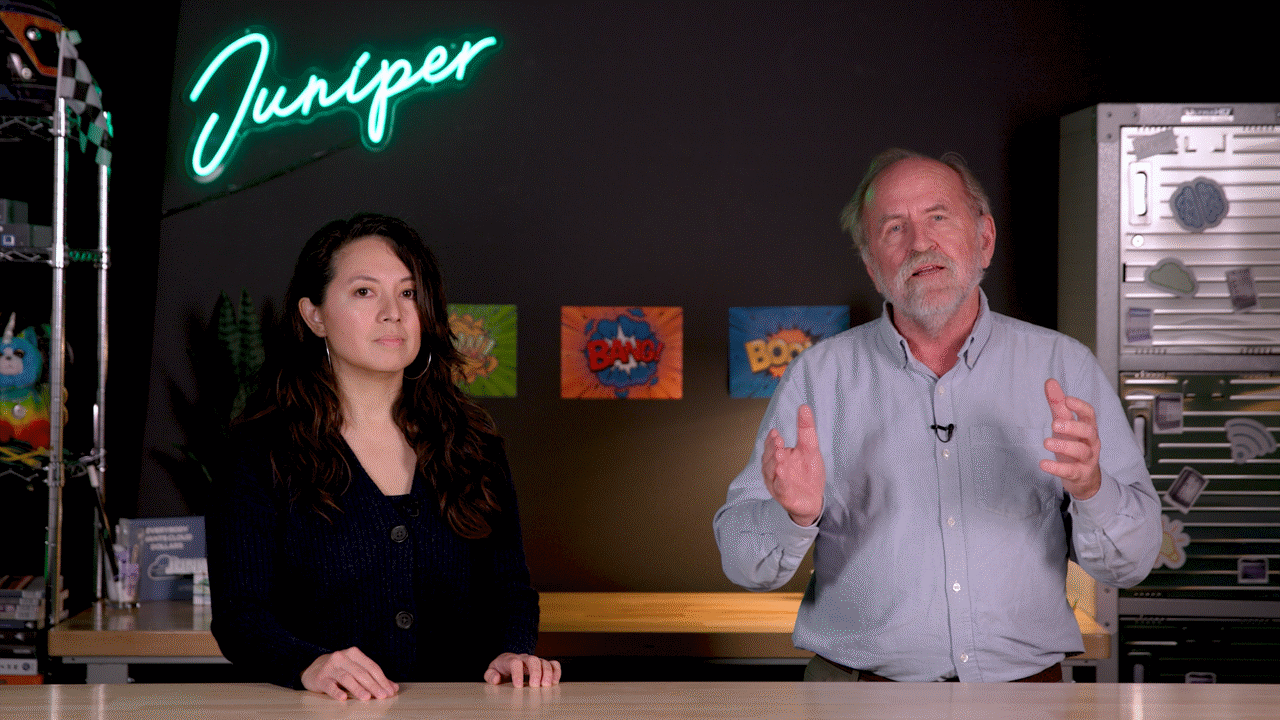Juniper Wi-Fi 7/6GHz and learnings, Dual 5 GHz Dual 6 GHz and RRM


Juniper Wi-Fi 7/6GHz and Learnings, Dual 5 GHz, Dual 6 GHz, and RRM
Wireless technology is advancing with Wi-Fi 6E and Wi-Fi 7. Currently, 50% of access points support 6 GHz, while Wi-Fi 7 client adoption is between 5-10%. Channel width affects user speeds, with a preference for 6 GHz, especially among Apple devices. Security features like WPA3 are mandated in Wi-Fi 7. The EU is planning future consultations, and understanding network behavior is key for effective capacity management.
Presented by Wes Purvis, Director, Wireless Product Management. Recorded live at Mobility Field Day 13 in Santa Clara, CA on May 7, 2025.
You’ll learn
Different deployment strategies and performance improvements for Wi-Fi 7
About the behavior of wireless clients and their preference for 6 GHz
Who is this for?
Host

Experience More
Transcript
0:00 hello everyone uh I'm Wes Pervvis and we're going to talk about
0:06 wireless can't start without uh talking about Wi-Fi 6E 6 GHz Wi-Fi 7 i wanted to
0:13 put up a a scorecard of kind of where you know what we see from our customers where we are um and so we are 2 and a
0:22 half 3 years into Wi-Fi 6E and of all of the uh Wi-Fi 6E capable
0:31 access points that we have shipped 50% of those APs have 6 GZ
0:36 enabled are those users who think they have 6 GZ
0:43 enabled but haven't enabled a WPA3 SSID no no this is those are radios that are shut off the Yeah the radios that Yeah I
0:51 looked at it the other way how many radios are enabled so these are 6 GHz radios that are enabled beaconing which
0:57 means they have WPA3 configured okay awesome thank you so there's a lot of room for improvement here although this
1:03 is even a year ago that number was 30% so there's there's been a significant uptick from a client adoption standpoint
1:12 we're in the 20 to 50% six gigahertz adoption depending on the environment so
1:17 if it's a BYOD environment like a university that number is uh usually
1:23 trends lower uh if it's a corporate environment and that uh with you know
1:28 corporate issued devices uh and that uh company has you know begun refreshing
1:33 with 6 GHz which many of them have starting several years ago uh we're seeing upwards of 50% or even higher in
1:39 some environments of of 6 gig clients from a Wi-Fi 7 perspective we're seeing
1:45 client adoption in the 5 to 10% range right now which is you know in you know first year of rollouts kind of what we
1:51 would expect that's what we saw with 6 gig So here's an example customer where uh
1:56 they deployed they have about 1,600 clients uh on the network about uh
2:02 34% so 530 at this point are connected on 6 gig and then uh 142 of those
2:09 clients are Wi-Fi 7 so just to you know this is where we are in the journey um
2:15 you know the six gig option is really uh is really picking up and then you know Wi-Fi 7 will take uh several years to to
2:22 reach a a critical mass that leads into all right how about
2:30 channel width right because channel width has a direct impact on the speeds that a user is able to achieve on the
2:35 network and so if we look at 5 GHz um our our default channel width you know
2:42 if you go deploy this network our default channel width on 5 gig is 40 MHz but the majority of our customers are
2:48 using 20 MHz on 5 gig which is great uh everybody or many people are changing the defaults which is always good to see
2:55 uh on 6 GHz the story is a little different uh worldwide we see uh
3:00 generally 80 MHz channel width uh that's our default uh in Europe the majority
3:07 channel width is 40 MHz because there's not as much spectrum i think over time as 6 gig
3:12 adoption increases these channel widths will shift left um so you know I think
3:19 you once we get appreciable adoption you'll kind of at least in the US with 1200
3:25 MHz if you do 20 mehz on 5 gig you'll you'll likely be able to do 40 mehz on
3:30 six gig in most circumstances uh and then in Europe you know probably
3:36 that means going down to 20 mehz uh in dense environments on 6 gig which some of our customers have already started
3:43 doing so then that brings up the question of how do clients actually handle 6 GHz like you know do they use
3:50 it do they connect uh and so what we see is actually a very strong affinity from
3:55 clients to 6 GHz they they generally prefer 6 GHz
4:00 um they're you know most of them are programmed to prefer wider channels but
4:05 even when 5 GHz and six gigs have the same channel bandwidth uh we actually
4:11 see very strong affinity so here is a a client that is roaming this particular client happened to roam 350 times over
4:18 350 times on this day and every single roam was on six was six to six now
4:25 that's not always the case you will see some some interband um but generally
4:30 speaking affinity is is pretty good and as an example here is a network that had
4:36 somewhere in the ne you know neighborhood of 26 27 26 or 27,000 clients in the past two
4:44 weeks so about uh 16,000 a little over 5 gig only right we we only ever saw them
4:51 connect on 5 GHz uh another 7,000 connected on five and
4:56 six GHz at some point in that two weeks so those are 6 gig capable clients but the most interesting stat here to me at
5:03 least is 3,000 over 3,000 clients connected on 6 gig only so in that twoe period we
5:10 only saw those clients on 6 gig they never uh they never connected on 5 gig
5:16 did you see did you see a preference for device type whether that's Android or uh Google
5:22 specifically Samsung iPhone did did you see a preference for one that that kind
5:28 of preferred preferred six only yeah so the the Apple devices from what
5:34 I see have the strongest affinity to six gig they you know you'll very you'll
5:41 seldom see them on on 5 gig in a in a like dualband SSID Um then Android is kind of next level
5:47 down and then Windows is usually kind of third um yeah sort of that's how I see um do
5:55 you have any stats on ML um not that I'm not in here yeah right
6:02 i'm just you know as you're talking about you know I wonder about lines that are coming on six and five six and two
6:08 four right right how do you how are you going to manifest how are you going to show roaming and Right yeah i'm not Yeah I don't have anything on MLO specific um
6:15 but yes you you know you have to show it all right and we will okay um okay so then but
6:23 kind of related the precursor to being able to do MLO is security right so
6:28 Wi-Fi 7 just like Wi-Fi 6E introduces some mandatory security features so Wi-Fi 6E
6:36 you had to do WPA3 right for any on 6 GHz you have to do WPA3 on a Wi-Fi 7
6:43 SSID that can be on any band there are a couple things that you have to do as well but one of those is GCMP 256 cipher
6:51 so you have to use GCMP 256 generally we're using CCMP 128 for most things today uh you have to turn on beacon
6:58 protection and you have on a WPA3 personal you have to turn on this SAPE
7:04 GDH or you know extended caps you'll also see it called Um and the way this
7:10 is manifesting and what you know actually what Wi-Fi alliance is recommending is generally speaking so
7:16 this is a you know beacon RSN element uh in the beacon you know I think most people are familiar with uh you know
7:23 with the AKMs the you know key management this is how the the AP the BSSID advertises hey this is this is my
7:30 security this is what I can do this I'm OWE I'm enterprise I'm I'm personal um but in the in the pair wise cipher list
7:37 uh You know typically that's always been CCM and you know at least for WPA3
7:44 but for Wi-Fi 7 you know generally the recommendation is to add GCMP 256 so you
7:51 will usually see both advertised on Wi-Fi 7 networks um it looks the same you know that you know whether it's you
7:57 know WPA3 personal enterprise OWE um you know you'll see multiple AKMs but now
8:03 you'll also see multiple uh you know ciphers as well so again every single
8:09 Wi-Fi 7 BSS has to advertise GCMP 256 has to advertise beacon protection and
8:15 then if it's has to advertise SE GDH so what does that mean for
8:22 roaming uh so uh now if you have a you know complete
8:28 Wi-Fi 7 network uh where you know you're going from Wi-Fi 7 AP to Wi-Fi 7 AP
8:36 security is the same on both sides AKMs are the same on both sides GCMP is there beacon protection's there very good
8:43 roaming so as you would you know as you'd expect you know roaming roaming is smooth
8:49 now I don't necessarily think that this will every customer deployment right
8:55 because many deployments will have mixed APs right there you know we don't yet
9:02 sell a Wi-Fi 7 outdoor AP um you know the in the real world we will have mixed
9:08 you know Wi-Fi 6 6E Wi-Fi 7 environments that's just the way it's going to be so
9:13 how does that look like well in let's say let's say you don't make any changes
9:19 right you you're you know you take your configuration as it is today with your Wi-Fi 6 or 6E APs and then you just add
9:26 Wi-Fi 7 APs with Wi-Fi 7 enabled it all works well with older
9:33 clients but the newer clients that are capable of GCMP 256 which there actually
9:39 quite a few of them out there now um you know because if if a client supports
9:44 WPA3 192-bit they likely already support GCMP 256 um and
9:51 so the problem is let's say I'm connected to a Wi-Fi 6 AP i'm connected at at CCMP 128 right i roam to the Wi-Fi
10:01 7 AP and as the client I say "Oh this can do GCMP 256 that's better
10:08 that's more secure than CCMP 128 i'm going to change to that." But the problem is it's not seamless you will
10:15 have a disruption there and and so what that means is really for
10:23 seamless roaming you have to actually enable GCMP 256 on your Wi-Fi 6 60 APs
10:31 for the most seamless experience and this doesn't matter security type because you have to turn on GCMP 256 for
10:36 every security type now this isn't all that different from you know what we went through with Wi-Fi 6E right you had
10:43 to turn on WPA3 you know you're probably not mixing just WPA2 and you know on your older stuff
10:49 WPA3 on newer stuff you know it's generally one shot so I don't think this is going to really be a big pill to
10:55 swallow um but just a it's it's a consideration to know about um that uh
11:01 you know you'll you'll have to turn on at least GCMP 256 on your older stuff um beacon protection doesn't really seem to
11:07 matter on the older stuff you it doesn't affect the roaming it It's really just the G GCMP 256 for the clients that are
11:14 capable of supporting it feels a lot like something I want Marvis to tell me and go fix yeah where the cloud will
11:20 just configure it yeah automatic miss this won't with MIS this won't really be a concern i just want to point out that
11:27 you know under the covers this is something that will that will happen and we've actually you know we've had you
11:35 know since Wi-Fi 6E with with WPA3 there's been a lot of discussions around you know client interoperability um and
11:41 we haven't seen interop issues you know granted we don't have massive exposure um to GCMP 256 but of the clients that
11:49 we've tested the environments that we've been in um turning on GCMP 256 seems to be a non-issue
11:56 do you only turn it on on the 6 GHz band nope you do it as well if you broadcast
12:01 you have to do it because Wi-Fi 7 you can turn on Wi-Fi 7 on any band yeah you're right so any any SSID that
12:08 broadcast Wi-Fi 7 that supports Wi-Fi 7 has to have GCMP 256 doesn't matter the
12:13 band okay but but you are saying that the clients that you've tested do support the GCMP 256 yeah the kind of
12:22 the newer clients um Yeah absolutely newer clients passion
12:28 basically any client that supports WPA3 192bit um which has been out you know for three or four years in mainstream
12:36 are these going to be the default values if I spin up a new new SS ID it's best interoperability correct and when will
12:43 these be the new values even if I don't have Wi-Fi 7 APs on my network um if you
12:49 there will be a we will tie it to a um value like the there will be a Wi-Fi
12:55 configuration option on the SSID if Wi-Fi 7 is enabled we will uh enable all
13:01 this other stuff okay now is there a standard name naming convention you're going to use or is has that been defined
13:09 by a group like like how it's going to look like in our UI wi-fi 7 enabled
13:17 disabled it's just like it's already there actually um it you know just like we had the Wi-Fi 6 enabled disabled box
13:24 it'll there's a Wi-Fi 7 enabled disabled per
13:31 WLAN all right that's roaming um so how do you actually migrate to Wi-Fi 60
13:37 Wi-Fi 7 so as I mentioned only 50% of our APs 6 gig APs have 6 GHz turned on
13:45 so there's a there's still a tremendous opportunity and you know when I talk to
13:50 customers like there's still apprehension out there I think mostly about WPA3
13:57 um you know there's some power um you know apprehension as well but mostly
14:03 it's WPA3 so like this is my you know high level blueprint of you know how can
14:09 you actually get to 6 GHz and now you know how can you also actually get to Wi-Fi
14:15 Well first and foremost try WPA3 you don't have to have 6 gig capable APs you don't have to have
14:21 Wi-Fi 7 APs even to get your feet wet with WPA3 and it you know it's it's
14:28 something that you should be doing today because you will have to go to WPA3 at some point now you don't have to do it
14:34 on every SSID and you can be strategic with it a lot of times what folks will do is on their1 access.1 accesss ID they
14:41 will they will turn on WPA3 for you know because that's been the lowest risk now
14:49 of course several years into into this right and there's been a lot of discussion on interop especially with
14:55 WPA3 personal largely not a concern anymore you know in most of our networks 99
15:02 99.9% of clients are you know supporting WPA3 uh personal um you know they're
15:08 still in the back of your mind hey am I going to have an interrupt issue but you know people that I've turned on just move on right if you you might
15:15 you know if you have a couple clients okay go deal with those uh and same for OWE uh we've had many customers now who
15:22 have turned on OWE or OWE transition for uh for guest networks um in particular
15:29 and uh it's been pretty smooth uh you know to the point where it's still on
15:34 right what what's your take on the IoT impact for WPA3 adoption
15:41 um I think so for IoT devices I think in many cases you're not turning on W
15:48 you're not turning on Wi-Fi 7 on that SSID um and the ones that you know the
15:54 ones that you are it's still like hey do they support WPA3 if they're not supporting WPA3 doesn't matter if it's
16:00 Wi-Fi 7 or not you know they're going to have they're going to struggle so you're thinking for the foreseeable future then
16:05 it's still advocating separate SSIDs for IoT largely because of WPA3 or lack
16:11 thereof support yeah and and it really comes down to device by device like you know there are many older devices that
16:18 certainly don't support WPA3 but I think we've even seen some you know recent devices IoT devices that aren't
16:25 supporting WPA3 uh and so it comes down to what's in your environment test it out see if it works largely you know
16:31 from our side we think it's not really you know a from working with you know a
16:36 lot of our customers not really a concern but you know give it a try see what happens uh next is design uh and
16:46 so what we have seen uh you know with the transmit power limitations of uh 6
16:53 GHz especially the asymmetry between AP and client uh it is most advantageous to
16:58 have a capacity based line uh where you know clients can you know have you know strong signal wherever they you know
17:05 wherever they are they don't have to be on the fringe of the cell um and where the the client TX power limitation would
17:12 be you know the seen the most um and then lastly is you know think about your
17:19 network what do you have from a switching perspective for PoE for for M gig um you know most of the Wi-Fi 7 and
17:25 6APs many of them need BT power for full functionality most of them have a AT
17:32 operating mode for reduced functionality we have many customers who use the AT operating mode no concerns there um you
17:38 know but think about the future if if BT is is appropriate as well as M gig um also not a requirement but a nice to
17:45 have now with three data radios wider channels um there are you know you can conceivably uh and MLO I should say you
17:53 can conceivably uh achieve more than a gigabit per second uh in real world conditions on
17:59 APs so this is the you know step one step two step three of you know how do you how do you actually get to Wi-Fi 7
18:05 how do you actually get to 6 GHz and so let's say you've completed this what you
18:11 know what happens to your network you know are there actually tangible benefits to 6 GHz um my answer is yes
18:19 and so it turns out we actually have a a actually a very good benchmark year-over-year so the same event a
18:26 one-day event held year-over-year uh so you know 2023 2024 2025 in 2023 the
18:33 first year that we did it the 6 GHz adoption was in the 10%
18:40 range and the the the graph here is the traffic uh by band so you know the the
18:47 six gigahertz traffic was you know very low you know I think even less than 10%
18:52 of the total traffic in 2024 the total amount of data transferred you know increased from 3
19:00 you know 3.8 terabytes to 6.8 8 terabytes and the 6 gig adoption was in
19:06 the 20 to 25% range and then uh you know overall traffic volume was you know
19:13 about a third on 6 gig this year traffic increased again to 11 terabytes right
19:22 more 6 GHz more capacity right traffic increases but most importantly the 6 gig
19:30 traffic volume is you know probably 40 45% where
19:36 and then 5 gig is you know 55% so the 6 gig you know contribution to
19:41 the network is is increasing you know maybe next year it will exceed it and this is this is a European event where
19:47 there's you know 480 mega spectrum I think you know results would actually look different in the US but it kind of
19:53 brings up the point of you know the way that we think about 6 GHz at least in Europe is it's really an extension of 5
20:00 gig you you've doubled your available channels uh and you know you can see
20:05 traffic profile matches so this is You know when I pulled this data it was very
20:10 encouraging to see wes for this event were you seeing airtime contention originally or yes so you've also
20:18 alleviated the airtime contention by using six gig as well right yeah that's one of the major benefits yes absolutely
20:25 wes it's great to see the overall RF traffic stats uh is there any
20:30 granularity as to you know what what is constituting you know the the up uh
20:36 swing in traffic like on a per application basis or there's there's um well okay not on it's this it's a you
20:43 know it's an event so it's mostly um you know email people posting pictures and
20:49 uh and whatever but um the you know there's more headroom for those people to do that stuff which is
20:55 why you know we're seeing the increase in traffic year-over-year here be interesting to see if how much
21:01 of it could be related to AI naturally i don't know um and and in the last two years
21:09 the six gig traffic volume increased 12 times do you have similar data for an event
21:15 that would be held like in the US or Canada where we could potentially have a lot more traffic not to this like this
21:23 is a it's a repeatable like it's the same thing every year you can compare yeah so it makes it very easy to compare
21:29 we do have US data but not to the same like Okay and then we're using 20 MHz Y channels on both bands um first two
21:37 years were 40s and then this year was 20s okay uh sorry uh 40s on six 20s on
21:43 five okay and then this year is 20s on both bands both bands okay
21:49 here's another example uh this is a large university customer who uh is
21:54 actually deploying about a thousand APs a month in session it's just incredible
21:59 uh but they have 60 70,000 clients on the network uh around the end of the
22:05 semester last year after Thanksgiving um uh they decided to enable WPA3 right
22:13 so they got their feet wet with WPA3 um and then a few weeks later at the end of the semester over winter break they
22:19 actually turned on six gig so when uh when the students came back after winter break this is the this graph is the
22:25 capacity SLE uh and so you know before 6 gig you know they're in the low to mid
22:31 uh 90% capacity which you know is pretty good for you know their size but by turning on 6 gig right away 25% of
22:38 clients connected and their capacity solely improved about 5 percentage points and at their scale that's a
22:46 significant uh significant improvement so there's tangible benefits to six gig
22:53 i'm a you know huge proponent of it you know the the roaming piece I think is sorted uh security largely has been okay
22:59 with especially WPA3 enterprise um and so yeah I want that next year i want that 50% number to be 70% and then keep
23:06 going up i would be remiss if I didn't talk about
23:12 2 x2 and 4x4 APS because uh you know this is what the industry has settled on
23:19 um and often you know the question comes up of why do you even have a 4x4 AP when
23:25 you have 2x two you know is 2x two all I need and so just as a you know refresher
23:31 this is uh you know 2x two transmit chains on the AP two receive chains um
23:36 and so when you look at you know the antenna polar plots often you'll see a line for each uh element each
23:43 transceiver and then you'll see an outer line that's the composite um that composite line is you know the um you
23:50 know usually would be with myo gain and depending on the vendor you know usually this is as measured hopefully it's as
23:56 measured some some people simulate but um these are from mistaps they're as measured uh and then 4x4 you have you
24:03 know four lines one for each radio chain and you know the composite line as well so the theory is you have um you
24:13 know higher you know more myo gain in 4x4 and you know better receive for MRC
24:19 um this is a MacBook client listening to the AP and so just by changing um the AP
24:27 from 4x4 to 2x2 in software right same AP same client location just by changing
24:32 config from 4x4 to 2x2 uh the signal as heard by the a as heard by the
24:39 client changed from neg 52 and a drop to neg 57 so the math would be you know usually
24:46 you would expect about a 3db change um going from 4x4 to 2 x2 in this case it
24:51 was five you know we live in an imperfect world it is what it is but you know this is this is just listening to
24:57 beacons right um and our AP is actually beacon across all chains which is why we see a difference here but you know this
25:05 is the initial piece of it okay signal you know we have a signal difference from you know we can have a more robust
25:10 signal with 4x4 how does that actually impact your data rates so if you look we looked
25:17 across um the missed universe we pulled uh you know data rate versus uh signal
25:22 strength on uh x-axis and the you know just looking at the trend right the uh
25:29 the trend goes up and to the right which means uh the data rates went up and
25:35 signal strength also went up for uh for a 4x4 AP same thing on receive side
25:42 where the trend is also up and to the right so there's a the biggest difference you know multiple multiple dB
25:49 difference in transmit and then you know slightly smaller you know one or two dB difference in receive um but uh you know
25:56 there's that has a actually a noticeable impact on the data rates again more robust link uh between AP and client so
26:04 does that actually relate to retries well it lowers the
26:09 retries which is good and then how does that actually relate to throughput throughput goes up um so you I'm not
26:17 getting you know super into the weeds here it's just meant to be a high level of um yeah there is actually a benefit
26:24 you have a more robust RF link and that does lead to speed improvements um you
26:29 know user experience performance on the network with 4x4 APs now does that mean 2x2 you know is useless no right it's
26:37 it's all relative like it's it's what you need on the network and certainly for the most demanding of of environments we would recommend 4x4
26:45 uh with this data would there be diminishing returns if you had a say 8 by8 or a 16x6 that is technically
26:52 feasible in the standard yeah you know you would see improvements but you know it gets to you know where does it start
26:59 start and stop mattering you know I I think with 4x4 we're kind of at that sweet spot of power price and
27:05 performance okay next up is uh the use of
27:11 directional antennas for everyday use uh and and so this is something
27:18 we've been exploring um we released uh the uh AP
27:25 47D this is a AP 47D um with directional antennas um you know built-in
27:31 directional antennas to the AP um and so the the reasons you know for
27:38 this AP are several and so we've seen a uh
27:43 increasing desire from our customers uh to have higher AP density in everyday
27:50 environments this is your offices you know maybe auditoriums in our retail customers as well where they need higher
27:56 AP density but if you're deploying omni APs even with you know our APs have 30°ree down tilt uh even with the down
28:04 tilt at some point you get to a point where you have too many APs your roaming sucks uh code channel problems it you
28:13 know you you really have to tune at that point when you you know when you've deployed too many APs for your
28:18 environment and so the solution to that is okay let's go deploy some directional antennas and typically we're doing that
28:24 with AP45E which works you know very well but feedback from customers is it's
28:30 kind of a pain you know we got to plug in the AP you know the connectors to the uh to the AP got to mount it it's harder
28:36 to make it look nice it's more costly to install and you know got to pay for the antennas um and so you know there's we
28:44 we've actually had like a a bunch of enterprise customers carpenter enterprise deploy 45
28:52 um in you know in their office environments right because they're they have such density such utilization in
28:57 the office you know that they need you know the directionality um that's why
29:03 there's a 47D for those types of environments um you know we think it's
29:08 going to be useful in those carpet enterprise in auditoriums it's going to be useful in uh even some of our retail
29:14 customers um you know to help support 6 gig uh density uh in those
29:20 environments this AP uh is specifically a 60x 60 uh square pattern um it you
29:26 know and so that gives the advantage of it you know it reduces go channel contention it reduces you know that the
29:31 AP can't hear as well so it doesn't there's other crap out there doesn't care as much about it and uh and clients
29:38 also don't hear as many APS which also turns out to be a big problem in in these really dense environments
29:46 any plans in uh having like a 40x 40 a 30 by 30 is that even doable like with
29:51 the physics no comment
29:58 uh you know this isn't a uh you know oneizefits-all
30:03 uh you know there's still absolutely a use for external antennas you know we but we released a AP47E with external
30:09 antennas uh you know especially in the more challenging environments like you know warehouse particularly we use a long narrow pattern uh style antenna or
30:16 high density where we don't have the 30x30 today and uh you know other other niche
30:22 environments um so as far you know as far as some testing here is a auditorium this is a
30:30 lecture hall at a university it already had 45 Z 45E antennas 45E APS with directional
30:39 antennas uh in this particular beam there's three APs we just took down the AP45 in the middle put up the
30:46 47D so from a a results perspective and you can't really make it out on the uh
30:52 on the projector but uh on the stream you should be able to see the color difference so the in the middle those
30:58 two APs in the middle are the 47D 5 gig and 6 gig and then on the left and right
31:04 on the top row uh are the existing 45e uh and so the the coverage pattern
31:10 between the 45E which is using a um you know on paper a like a 45x 45 antenna I
31:18 think um is uh you know the pattern is actually very
31:25 similar which is uh which was encouraging to see this particular customer was very happy they're going to
31:30 actually go forward you know all their autom going forward will be 47D it gives them the added benefit of they can
31:37 support low power indoor on the AP they don't have to worry about standard power um and then for uh for comparison the
31:43 the two bottom APs are Omni 45s that just you know permeate everywhere in the
31:49 room uh so there's you know absolutely benefits for the directionality um you know for this particular environment uh
31:55 so I just wanted to show some some real values real testing so why the 2x two for the 47D when it's expected to be
32:02 used in higher dense higher density spaces um they didn't have full uh full power
32:08 we didn't fully power it okay so the you know for this testing we didn't really
32:14 care about it um but yeah just to note the Oh so the the product is 4x4 correct
32:21 okay it just wasn't in this test correct and you know so you can you can account for that you know the the signal
32:28 strength doesn't match up exactly you know with the uh with the 45D you know mostly we we actually see about a 3db
32:35 difference which is what you expect going from 2x2 to
32:40 4x4 okay and then next piece um is dual 5 GHz and dual 6 GHz uh AP47
32:48 uh is capable of dual 6 GHz um as well as dual 5 on our previous APs we've
32:53 supported dual 5 as well and I want to get into a little bit of the uh nuance
32:59 that we've learned uh with dual 5 over the years so first is you know most
33:05 vendors out there and this is how we you know do our dual 5 have settled on this this sign of you know this kind of
33:12 architecture where you have one radio that uses the lower portion of the spectrum one radio that uses the higher
33:18 portion of the spectrum and you put a band pass filter in the middle so you you know you can achieve incredible interference rejection with you know
33:24 with the collo colllocated radios uh same thing on 6 gig you know we're using uni5 low band uni 6 uni7 and uni 8 as
33:33 high and then you know uni5 uni 6 as a guard band which means for Europe uh and
33:39 UK and other countries with 500 MHz spectrum dual six not useful right now
33:45 for you um however actually today 40 minutes ago the UK had
33:52 consultation uh for opening up the entire uh 6 gig band for um
34:00 uh you know for indoor use now this is consultation they're taking feedback um it just closed but that would be
34:06 actually very encouraging um for you know opening up the additional spectrum and you know they also want to turn on
34:13 you know AFC for outdoor use cases that would probably be longer term but if you
34:19 read actually phase one ideally by the end of 2025 so that's very fast in uh in
34:27 spectrum timelines regulatory timelines so we'll see you know actually comes back in the consultation but this is
34:33 what they want to do at least and would help with the you know dual six uh in uh
34:38 in UK and is said EU is still in planning do you do you know what they're Yeah so EU had a um I forget what the
34:45 MRD or they had they had their radio group cons you know consultation two
34:51 years ago the next one is in 2028 or something oh good lord um and so they
34:57 said we want to do it but we'll decide by the next one
35:02 thank you yep um so then what does that you know actually mean in terms of channelization
35:09 well on dual six sorry on dual 5 you have eight channels on lower and you
35:16 know depending on you know 16 17 on higher AP47 we support uni4 so there's
35:21 actually 20 channels on the upper that channel mismatch right is turns out to
35:28 be a problem it means that you can't just turn on dual 5 everywhere because then you've reduced the number of
35:34 available channels that you have right you run into channel reuse issues especially if you do 40 MHz you have
35:39 four APs before reuse issues on six gig not so much of an issue uh because the
35:45 it's more equitable there's a better balance now you know to just really drive home
35:52 the 40 MHz point uh you can you can see in here there's a lot of reuse so this
35:59 is um this is like an example of what not to do but it kind of drives my next
36:04 conversation which is um you know let's let's think about what are we actually trying to do we're trying to increase
36:11 the capacity on the network by having you know more available radios on on 5
36:16 gig or 6 gig so it turns out not all capacity issues are the same kind of comes down
36:21 to hey maybe I need to add some more APs like my clients are you you know using there's no other capacity there's no
36:27 headroom I need to add more APs or you know conversely it could be I have too many APs I'm I'm interfering with myself
36:34 or a neighbor's interfering with me and and so that leads us to how do we actually like let's actually bake that
36:42 into RM from you know we've had this auto conversion feature for many years um it's worked incredibly well we use it
36:48 all over the place where we can convert automatically the 2.4 radio into 5 gig into 6 gig now in
36:55 AP47 but what we have seen is in many instances the radios that we're
37:01 converting aren't actually the highest utilized APs that could benefit the most
37:07 from that additional radio in 5 gig or 6 gig that's what we want to solve so
37:12 today we have a density based approach where we're looking at the density of APs do I have enough density to support
37:20 um you know this auto conversion or auto cancellation what we are moving to is a
37:26 capacity based approach you know sounds simple but there's actually a like a lot
37:31 that goes into it um and so we we change our questioning from do I have enough density to can I do it do I need it
37:41 where do I need it right so can I do it is like are there enough channels enabled in my configuration uh how many
37:49 other APs do I hear like you know are there available channels from a capacity standpoint for me to do it um like do I
37:56 need it meaning do I actually have the util utilization characteristics to take advantage of of you know additional 5
38:03 gig radio additional 6 gig radio and then where do I need it right where where on the network do I need it so I I
38:09 on a previous MFP I've shown this slide which is we want to learn the behavior
38:14 of the site you know what is the 5 gig utilization 6 gig utilization what is the roaming how much dwell time you know
38:20 all these you know things and so this we are we are learning we are doing and that feeds into this new uh you know
38:28 reimagination of the auto conversion part of RM so this uh this plot uh on the left hand side is
38:39 um it's a uh you know it's an environment the blue APs are APS that
38:44 we're happy with there's no like they're happy as they are right they have plenty of headroom the red APS are APs that are
38:51 the high utilized APs that are having capacity headroom issues these are candidates for auto
38:58 conversion on the right hand side is actually what the algorithm did right so the first step is we have to identify
39:04 these high USAPs second step is let's go you know let's actually go convert so you know many environments especially in
39:10 retail you may not have all the available channels they may you turn off some of the DFS channels so this is with
39:16 15 available channels in their you know in this configuration um the black APs turned out to be the APs that we
39:22 actually converted um and so this is you know
39:27 okay so what does that actually mean well uh here is here's the outcome looking at um looking at one of these
39:34 APs the blue lines before and then the red and the green is after on both radios so blue before if the lefth hand
39:42 side is the number of clients versus the number of samples so there's you know you know mostly 15 to 25 clients on the
39:49 AP uh after the number you know we had actually good distribution between the
39:54 radios in terms of number of clients that decreased utilization is on the graph on the right uh utilization
40:01 decreased significantly after was it going to dual 5 or dual 6 uh dual 5 this
40:08 is five um this is a AP43 customer okay and
40:15 uh and and then the actual throughput in the AP went up as well so that's the
40:20 entire goal of this exercise is how do we identify the APs where we have headroom issues and then let's go figure
40:27 out if we can alleviate that and and going forward how are you going to make
40:32 a decision between where you go to a dual 5 or dual six so if you go yes we need more capacity are you going to look
40:39 at like how many clients on each bend or is this this is why we have to learn the
40:44 behavior of the site we can make those decisions we can make a bandwidth decision as well like you know do we do
40:50 we change the bandwidth do we change the band do we go five do we go six do we mix it yes that's why we need this this
40:56 is the foundation of understanding the behavior in the site then we can do all this other stuff and so this is going to
41:01 be sort of a a a learning thing that occurs after your miss network is up for
41:06 6 weeks you then have the option of doing the thing because we've learned enough about your network or is this
41:12 going to be a model that applies to all networks uh this will be a learning based on your network okay um and so
41:17 when you deploy you know we will do some stuff right away and then over time it'll get better so you know it's it's
41:25 not like you're sitting there waiting um but over time we will you know even today we you know if you stand up missed
41:31 APS you know the second day third day the RM even gets better because we have that reinforcement learning loop okay
41:38 and this would be part of that obviously okay absolutely I had a question if you make those
41:45 changes to the black ones how do you know it was a good change part of the reinforcement loop so
41:51 we actually we looked so today we're already consuming our capacity SLE and coverage SLE and roaming SLE's so we
41:58 make a change i should have put the slide in i was thinking about it uh so we make the change we monitor you know
42:04 these are representation of of client experience so if capacity goes down that's a bad change right if cap
42:11 capacity goes up if we're actually trying to improve our headroom so if the headroom goes up then that's a good
42:16 change we stay today we don't today like in today's algorithm we only go one way
42:22 um we will go two ways in the new uh in the new world is there something
42:28 planning to get rid of the other red ones um the problem is
42:35 uh in this particular case uh they als like like how so how do we get to dual 5
42:41 how do we get to dual 6 we convert a 2.4 radio they have 2.4 utilization so we
42:46 have to be cognizant that there's 2.4 utilization and not cause coverage gaps um and the the other problem is in this
42:55 particular environment they only have 15 available channels so if I convert more radios to dual 5 I'm not actually
43:02 picking up any capacity gains but but could it also recommend you should go to six gig i mean in this scenario you need
43:09 different hardware correct correct yeah that would so that is absolutely part of
43:15 uh you know we have to we have to recognize when we've done all we can and there's simply no more capacity
43:22 will customers be able to blend both a density approach and a capacity
43:27 approach to you know the optimization of the site yeah so we the capacity
43:34 approach consumes the density approach where we are still considering the density of APs to make sure there's sufficient density uh you know to
43:41 support any 2.4 utilization all right so so the reinforcement learning algorithm
43:47 you mentioned it takes into account capacity roaming and what was it for you mentioned free uh coverage coverage
43:54 because has that changed recently because did it used to just be capacity it used to be capacity coverage and two
44:00 or three years ago we introduced a roaming SLE for the purpose of feeding into RM

























